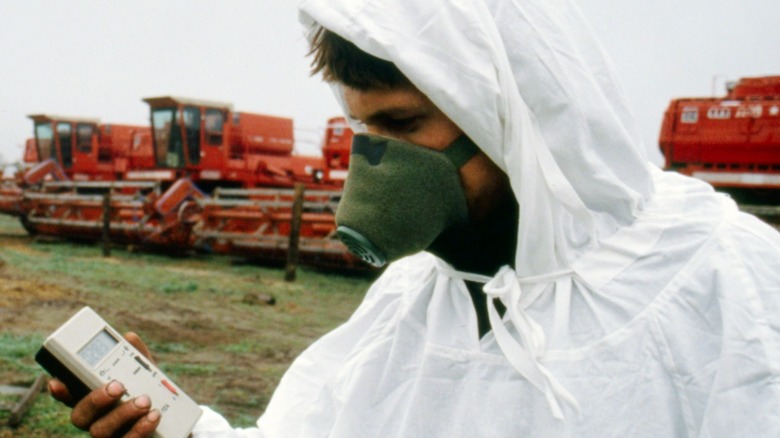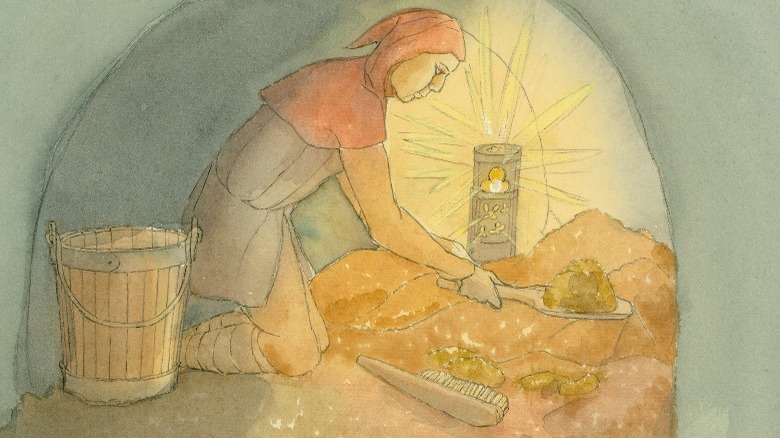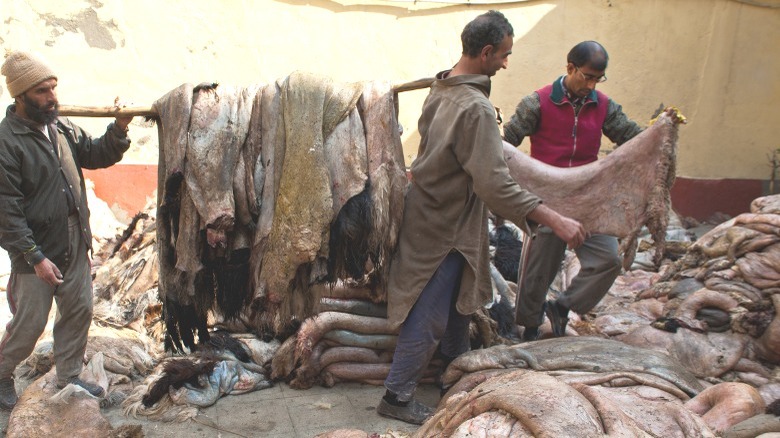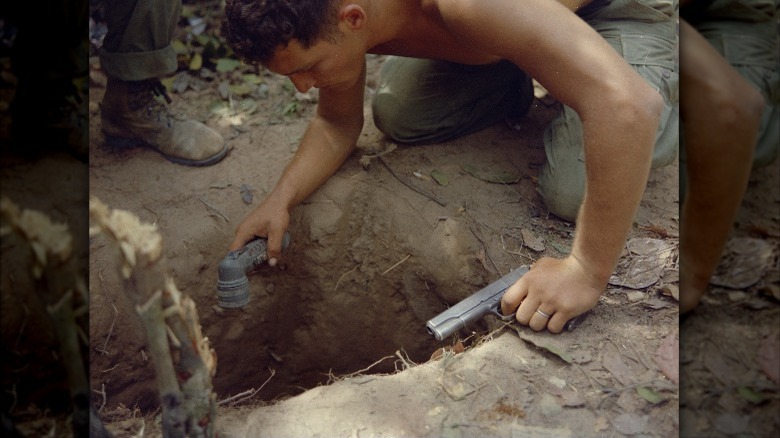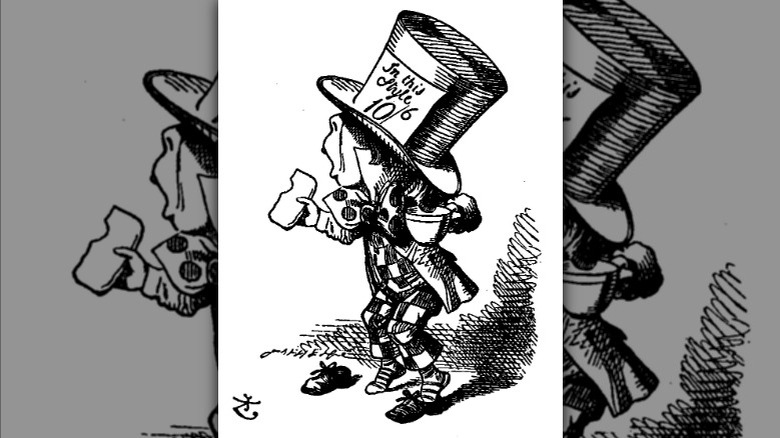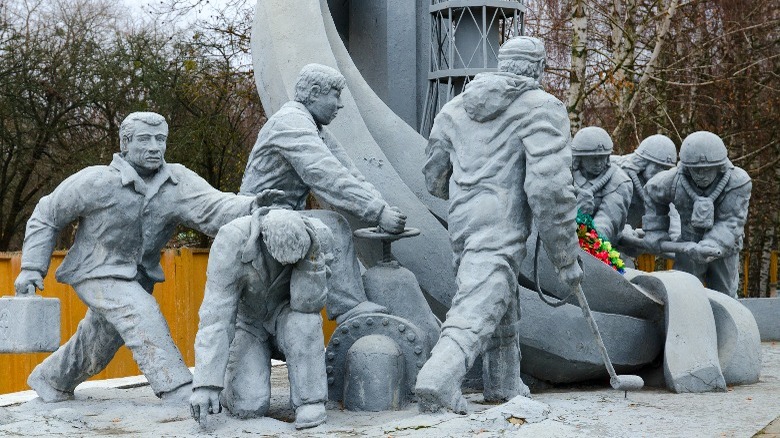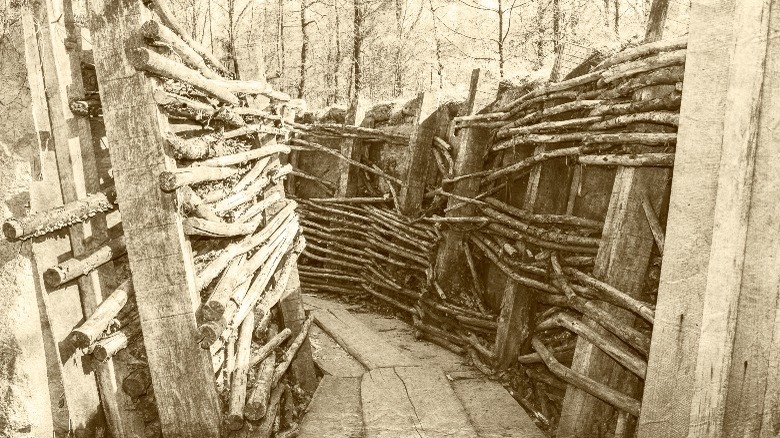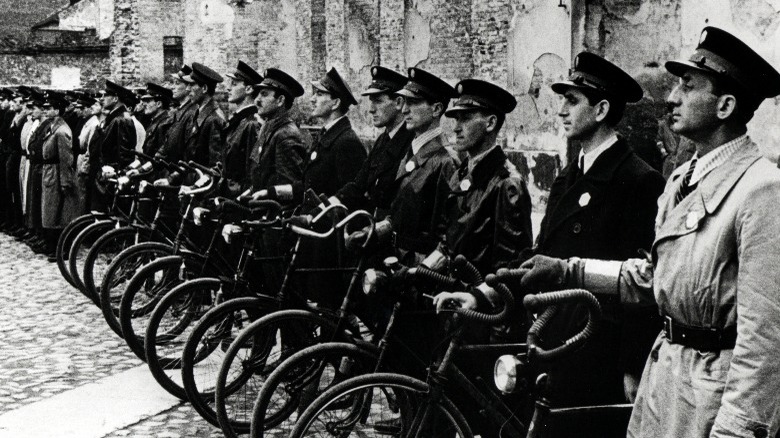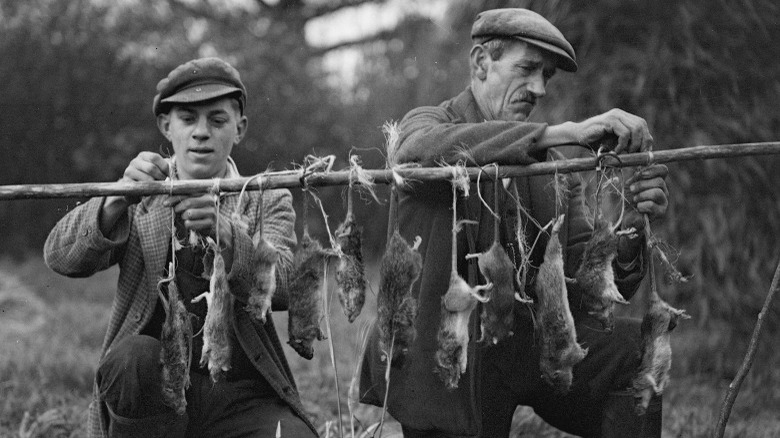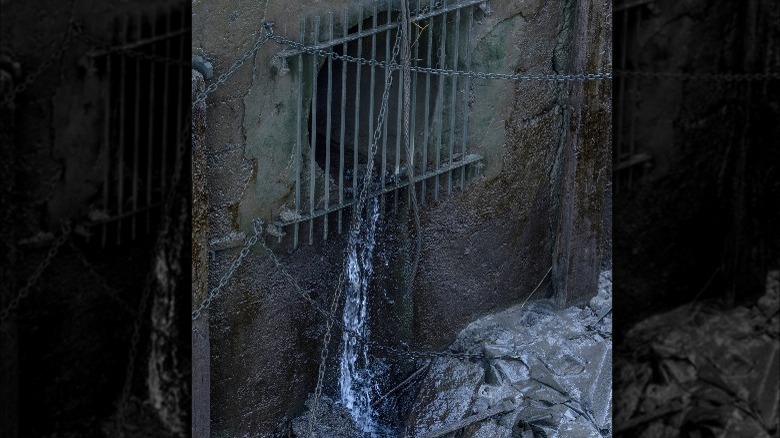These Are The Worst Jobs In History
There are millions of workers who punch in and out of work at a bad or boring job, while some jobs are much more prestigious and "fun." For example, very few people would rather be a plumber or garbage collector than a Hollywood actor or sports TV analyst. Still, even the worst jobs today (in the United States, at least) come with a modicum of respect and dignity, which is something that can't always be said for employment throughout history.
Historically, before the rise of modern conveniences like plumbing and modern medicine, it was the poor class of individuals who often had to sacrifice their bodies — and sometimes their minds — in order to earn a living. In addition, fighting in a war brings its own set of terrifying tasks and assignments. These are some of the worst jobs in history — and you thought your boss was bad.
Gong farmer
Of all the jobs in history, potentially the most disgusting was that of the gong farmer. If you were hoping that the job involved either traditional farming or using a gong-type instrument, you are sadly mistaken. Unfortunately, the term gong farmer comes from the word "gan," which means to use the restroom. Back in medieval Europe, they did not have modern plumbing systems like we do today, with toilets, sinks, and underground pipes that transport excrement.
Instead, for the most part, they used latrines, which were giant pits that people stood over to do their business. Additionally, most families did not have their own individual pits; often entire villages or towns would have a set of communal latrines that they would use together. Enter, the gong farmer. It was the gong farmer's job to empty the latrines overnight, and it was just as foul and vile as you would expect.
Working as a team, several men would storm the pits during the night hours — when everyone was asleep — and shovel and transport the excrement out. Undoubtedly, the worst job was that of the shoveler, who had to actually remove the waste from the latrines and get it ready for transport. Apparently, they would take whatever of value was accidentally dropped into the latrines, which might be the worst form of medieval tipping ever.
Leather tanner
The history of leather is incredibly rich and long, dating all the way back thousands of years to the earliest civilizations in Egypt and Mesopotamia. According to Dr. Josephine Barbe at Maharam, 10,000 years ago the first waterproof leathers came into existence, and 5,000 years ago actual leather tanning first started. The Romans also used to tan leather starting just under 3,000 years ago, and even today leather is still one of the most popular textile products in the world.
However, the job of the leather tanner is much more dispiriting. Today, much of the leather that makes its way to Western countries is the product of Asian factories, with many of them based in countries like India. The work is done by economically poor individuals, who live in impoverished conditions because the job also does not pay well. However, that may not even be the worst part, as the job is also incredibly dangerous.
According to a study published in the Indian Journal of Occupational & Environmental Medicine, just working as a leather tanner opens you up to risks of several different cancers and diseases, including lung cancer, melanoma, and soft tissue sarcoma. This is mainly due to the incredibly caustic and hazardous chemicals that are used in the process, including chromium, arsenic, and various solvents like formaldehyde. Leather may look nice, but it is a terribly dangerous and unsafe job to manufacture.
Leech collector
Though it is not very widely used today, there was a time when using leeches as medicine was seen as the cutting edge of pharmaceutical technology and used for all sorts of ailments and illnesses. Leeches are small black worms that feed on, of all things, blood. They use incredibly sharp teeth and suckers to penetrate and extract the blood, and some of them have venom that actually prevents clotting, leading to sustained bleeding if untreated.
The leech fever really took off in the 18th and 19th centuries, which caused a huge demand for them in Europe and the United States. This resulted in the unfortunate rise of the leech collector, whose job it was to procure the thousands of leeches needed to satisfy medical demand. While leech bites aren't very painful, it's not exactly fun, and removing the leech from the body is much worse. While some people used horse limbs as bait, others used their bare legs and feet, which was cheaper but also much harder to endure.
Often, collectors would have to let the leech stay attached long enough to acquire a decent amount so they could take them off easier, which also meant the leeches had time to transfer unwanted diseases and illnesses. The collectors had to get the leeches from decidedly objectionable places, like bogs, swamps, and marshes. The job was usually reserved for the poor, the only ones desperate enough to do it.
Wool fuller
Beloved by some as warm and comfortable, and alternatively hated by others for being itchy and prickly, wool has long been one of the most popular and widespread textiles for clothing and housewares. However, when manufacturing textiles, wool cannot just be taken from a sheep or goat and simply sewn together. There are a series of processes — known as fulling — that need to be done to transform the wool fibers from animal to textile. These were done by workers known as wool fullers.
Part of the process of fulling requires treating it with a solution and beating it to link the wool fibers together. While there were mechanized options available, others did the process by hand, or, well, by foot. The fuller would spend his days walking back and forth on damp wool cloth, which would make it much softer. Considering the enormous demand for wool at the time there was a considerable amount that needed to be fulled, leaving the fuller in high demand.
However, while trampling on wool doesn't sound bad, the substance it was soaked in is what made the job so horrible. The wool was soaked in stale urine — due to its source of ammonia — before the fuller would get to it, leaving it with an imaginably awful smell. In addition, fullers did not wear shoes and stomped on the urine-soaked wool in bare feet. Just imagine getting an itchy foot from the wool, yuck.
Vietnam War Tunnel Rat
Fighting in the jungles and rice paddies of southeast Asia during the Vietnam War was incredibly dangerous for virtually everyone in the country, especially those who were fighting in combat. Still, even among combat roles, that of the "tunnel rat" stands out as one of the most physically treacherous and psychologically challenging. Tunnel rats were forced to enter into underground mazes built by the Viet Cong, who were the American's main enemy during the war.
The Viet Cong used an elaborate series of underground tunnels to sneak around the country, which at first allowed them to remain undetected. However, as soon as the U.S. started sending large amounts of troops over in 1966 they discovered the tunnels, and it quickly became a priority to destroy them and those dwelling inside. The tunnels were built well enough that just bombing over top of them was not good enough to make them collapse, meaning they had to be eradicated from the inside out.
This led to soldiers having to crawl into the tunnels themselves, which were absolutely tiny. Once inside, they faced all kinds of dangers, ranging from enemy soldiers, mines, and booby traps, to poisonous snakes and gas attacks. Armed with only a pistol and flashlight, they had to systemically root out each tunnel one by one, a tedious and arduous task. It was incredibly dangerous and led to a high casualty rate, and was incredibly hard to endure psychologically, as well.
Women of the Bordel Mobile de Campagne
Since World War II, there's been a gigantic shift in how sex, sex work, and consent are viewed in the West. While it is somewhat appalling and shocking to learn today, until fairly recently there were actually sex workers attached to fighting army units. In the French army, these were known as "Bordels Militaires de Campagne" (BMC), or mobile field brothels. In contrast to many militaries, the BMC was actually sanctioned and sponsored by the army itself, with the idea it would stop the spread of disease and allow men to keep up their spirits and fight harder. However, while it may have benefitted the male troops, it was quite a different story for the women involved.
War correspondent Bernard B. Fall described the system in his book "Street Without Joy." When French soldiers served in Vietnam in the 1950s, many of the BMC women were taken from the North African Ouled-Nail tribe. Once in Vietnam, they would be moved by truck to the different squads. They also served as combat nurses — with many dying on the battlefield.
At the time, correspondents like Fall rationalized the system and insisted the women actually enjoyed the job, but the truth is likely far murkier. They were victims of state-sponsored sex trafficking, who were seen as only sexual tools instead of human beings.
Hatter
It might sound a bit strange on the surface, but the job of hat-making actually used to be fairly dangerous and unhealthy. While today the job is largely done in factories by machines, it used to be the purview of individual hat makers who were known as hatters. These hatters would hand-produce the hats largely out of the furs of animals, as that was the popular textile of the time.
In order for them to successfully turn the fur from animal skin into soft felt, hatters often used a mixture of chemicals. Often included among them was mercury, which was not known at the time to be poisonous like it is today. As a result, hatters willingly used large amounts of mercury nitrate during their hat making, which in some individuals would lead to mercury poisoning. Mercury poisoning often manifests itself in a myriad of ways, including physical tremors and mental hallucinations.
Additionally, the phenomenon also gave rise to the term "mad as a hatter," which was part of the basis for the Mad Hatter character in Lewis Carroll's "Alice's Adventures in Wonderland." Though it was portrayed rather humorously in the book and subsequent films, it was a serious issue for those who were affected, and definitely no laughing matter.
Chernobyl responder
One of the worst nuclear disasters in history occurred in April 1986 at the Chernobyl nuclear power plant in what is now Ukraine. A reactor exploded, instantly killing a scientist, and causing multiple fires to break out which released radioactive gas. Nowadays, the dangers of nuclear radiation and fallout are pretty common knowledge among most people in nuclear-armed countries, but back then it was not. Not even among the first responders.
According to a speech given by one of the first responders (via the Associated Press), Lt. Col. Leonid Telyatnikov, the firefighters who showed up to fight the blazes had no idea that they were ingesting potentially lethal fumes. This resulted in severe cases of accurate radiation syndrome (ARS) in many of them, as well as the deaths of six firefighters. Several of them collapsed from the sickness, though many of them later recovered and lived.
In addition to the first responders, there was also a group of roughly 600,000 people known as "the liquidators" who came in after the immediate explosion to help contain the fallout and damage. Aware by then of the potential effects of radiation poisoning, they volunteered to come and clean up the area knowing they were risking early death. Tens of thousands would end up either dead or permanently disabled from the exposure, though they saved countless other lives by stopping the outbreak. It's hard to imagine a worse job than fighting nuclear radiation, no matter how bad your boss is.
WWI French soldier
The First World War was one of the most destructive conflicts in human history. Deaths during the war exceeded 16 million, and the countries of France, Germany, Austria, and Russia, were completely devastated by years of destruction. The majority of the war on the western front was fought from the trenches of France, where the French-led Allied Powers took on the German-led Central Powers.
From the beginning, the French soldiers were on the defensive when the war began with a German attack in the summer of 1914. The French casualties were enormous over the next three years, including losing more than 27,000 in one day in southern Belgium and having more than 400,000 during the Battle of Verdun. The trench life they had to live was also unfathomably bad. Disease and infection were lurking everywhere, including being transported in rats and other disgusting creatures. That doesn't even include the occasional artillery barrages and bayonet charges that the Germans would throw at them.
Additionally, the constant bayonet charges that the French soldiers themselves had to embark on were also incredibly unpopular. Many times, they essentially turned into suicide runs, with soldiers running over their fallen comrades on their way to their own certain deaths. Things got so bad, the French army actually mutinied in April 1917, refusing to go on any more suicidal bayonet runs. The army recovered and went on to win the war, but life as a soldier was absolutely brutal.
The Judenraete and Jewish Ghetto police
During the Holocaust, it is estimated that 6 million Jewish people were systematically murdered by the Nazis. Often, the populations of Jewish residents in the various European countries that came under Nazi control were stuffed into undersized and unsanitary ghettos.
In order to administer the ghettos the Nazis also created the "Judenraete," or Jewish councils. These councils were made up of Jewish residents in the ghettos who were forced to carry out the Nazi's orders and disseminate their information. They had to give up their own friends and families to the concentration camps, and anyone who refused to do so was murdered for their insubordination.
The members of the Jewish councils had to walk an impossible tightrope, where they were hated from all sides. The Nazis did not consider them equals in any sense, and the Jewish residents often saw them as traitors and collaborators. This took a serious psychological toll on many of the Junderaete, and several of the members took their own lives out of desperation. Some of the most hated of all were the Jewish police forces. The only incentive for joining was to escape forced labor and the concentration camps, but the Nazis just murdered them in the end like everyone else.
If you or anyone you know is having suicidal thoughts, please call the National Suicide Prevention Lifeline by dialing 988 or by calling 1-800-273-TALK (8255).
Rat catcher
While most people probably don't think about it until they need to, the world of pest extermination is ever-evolving. Today, exterminators are very widespread and can usually be booked fairly easily over the web or phone. Typically, they use chemicals or humane traps to catch the critters, ending infestations as compassionately and professionally as possible. It's quite a far cry from the previous days of rat catchers, who would employ all sorts of (now) outdated and inhumane techniques.
As Ike Matthews wrote in his 19th-century memoir "Full Revelations of a Professional Rat Catcher, After 25 Years' Experience," rat catchers of old used a litany of approaches to get rid of pests. These included using animals like ferrets and mongooses, baiting them with aniseed oil or rhodium oil, and using fake squeals to force them out of tight places. In addition, most of the places where rats were living were "dirty and obnoxious," making them not fun places to set foot in.
Catchers were usually forced to work at night, and would also be called upon to provide rats as fodder for hunting at beerhouses. They were at times ostracized when they would carry around their trapped rats, getting uneasy looks from people uncomfortable to be around them. Still, even though they had to do these dirty and disgusting jobs, rat catchers could still look at themselves with pride and feel they were contributing a valuable service to their communities.
Tosher
Modern plumbing provides us with so much convenience and sanitation that they can easily be taken for granted. With the exception of toilets and sinks, most people don't ever have to see the plumbing in their houses or in commercial buildings, as it is all neatly tucked away behind walls or underground. However, still in use are massive sewer systems that transport tons of excrement and waste from one area to another.
In 18th-19th century London, as you can probably imagine, the sewers were filled with some of the most foul-smelling excrement one could possibly experience. It was the job of the tosher to travel into these repugnant and revolting sewers and trudge around looking for any valuables that had accidentally been lost. They would reach their arms into disgusting passageways and cracks looking for a few shillings or other coins.
They would often work in large groups and sometimes had colorful nicknames like Lanky Bill and Short-armed Jack. The term tosher comes from the word tosh, which was London slang to indicate things of value that were taken from drains and sewers. It was dangerous to walk the sewers, not least of which because of the ever-lurking disease and rats. Eventually, the authorities made it illegal to enter the sewers, but that did not stop the toshers. Some of them were quite successful, with them making enough to be considered upper-working class, though at the price of doing a decidedly terrible job.
Whipping Boy
Most people have probably heard the term "whipping boy" before, usually in the context of being labeled a scapegoat or being blamed for another's problems. But would you believe that it actually used to be a job? The evidence is somewhat circumstantial, but many historians posit that some royal families used to employ whipping boys for their children.
These were the days when corporal punishment was common, and it was the job of the whipping boy to take physical punishment that was meant for a young royal. Compared with a royal, their teachers were rather low on the social scale, making it inappropriate for them to punish one themselves. So instead, they would lay into their whipping boy companion, which would somehow teach the royal his lesson.
The psychology makes basically no sense, and almost seems like it was more to please a sadistic teacher than to help the student. Today, it's impossible to know whether this phenomenon is real, and it has not helped that several popular books, like "Game of Thrones," have included whipping boys in their plots. Whether or not it was a real job, everyone can agree that it does indeed need to stay a part of history, and never return.
